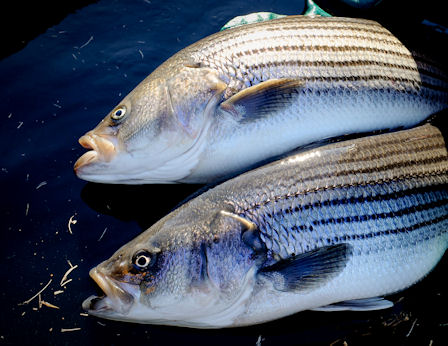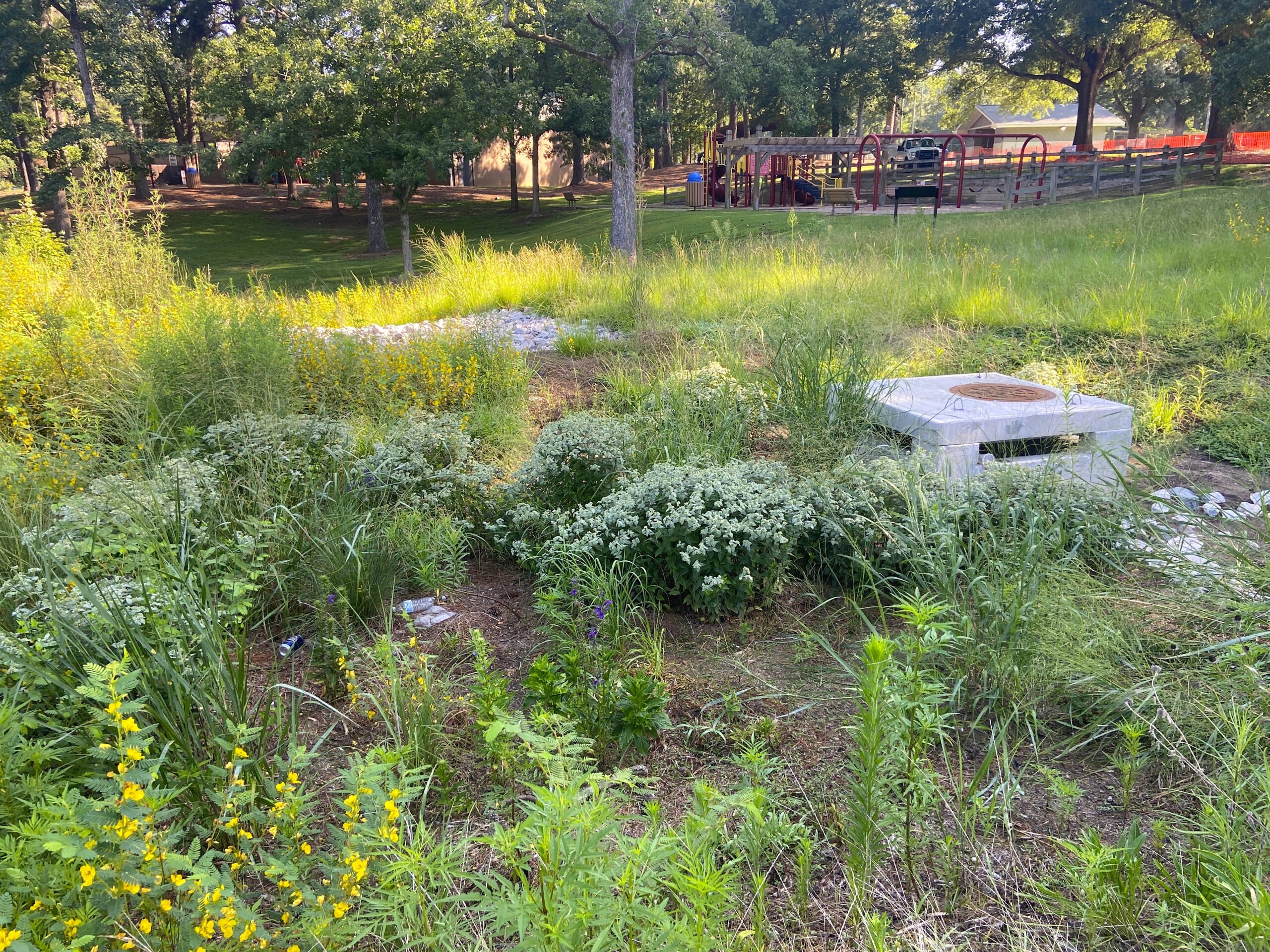Juggling Hybrids and Homes: Balancing Fish Farming and Local Development

The first season Lee Brothers raised hybrid striped bass fingerlings on his farm, he slept in his truck every night.
“I was scared to death,” he admits, adding that he would get up several times during the night to check oxygen levels in the tanks holding the young fish. “No one knew anything about fingerlings back then.”
That was 1998. Today, Brothers sells two million fingerlings per year to other hybrid growers. He has 50 earthen ponds, and raises hybrid striped bass year round as food fish and fingerlings.
“It’s like a marriage,” he says, half-jokingly. “You get out of it what you put in it.”
When Brothers first started raising hybrids in ponds in 1987, his was the first operation in the United States. A cross between the white bass and the striped bass, hybrids are popular in the sushi and sashimi markets of the Northeast, typically selling for $3 per pound live and about $2.50 per pound on the fillet market.
Now Brothers has one of five hybrid striped bass farms in Beaufort County — which has more farms than any other county in the state. North Carolina has 19 hybrid producers, the most in the United States. Production here is worth approximately $7 million in farm gate value, or the net value of the product after it leaves the farm and marketing costs are subtracted.
“This hybrid stuff is high risk, high profit,” says Brothers. “But then again, I’ve always been a gambler,” the Aurora native adds with a smile.
Perhaps one thing Brothers, and other area hybrid farmers, didn’t bet on was the recent influx of people into this beautiful, rural watershed county.
Like any agricultural activity, farming fish means dealing with animal waste. For hybrid striped bass farms in North Carolina, the standard practice of releasing effluent from ponds into nearby creeks and streams is controversial.
During the last several years, Beaufort County has experienced noticeable growth and development. From 1990 to 2004, the county’s population rose more than 8 percent, according to the U.S. Census Bureau. That may not sound like a lot, but for an area with only 54 people per square mile, new faces don’t go unnoticed.
Many of these suburban-like developments are downstream from hybrid striped bass farms, and some residents accuse these aquaculture operations of causing fish kills and algal blooms in local waterways.
As the county’s population has increased, the N.C. Division of Water Quality (DWQ) has received more complaints about degraded water quality, says Al Hodge, the regional supervisor for the DWQ in charge of surface water.
There is also some concern among longtime residents, he adds. “Some residents worry about a drop in water quality affecting their property prices in the future.”
Hodge has received nine complaints about different hybrid striped bass farms, but only two farms in the area have been documented by the state as “contributing to water quality violation standards.”
“The water is green coming out of these ponds — it is easy to see,” says Harry Daniels, a Sea Grant aquaculture researcher from North Carolina State University. “People associate algae with water that kills fish, but sometimes the water isn’t so bad.”
Hybrid farmers have been exchanging water in their ponds for years, according to Daniels. If farmers saw water quality in their ponds deteriorating, they would simply drain off some of the water into nearby streams, known as “receiving waters,” and replace it with clean well water.
“But these places are no longer just farming communities,” says Daniels, who, along with North Carolina Sea Grant Director Ronald Hodson, is interested in researching farming practices to help mitigate the effect of effluent.
Public pressure may be the impetus for hybrid striped bass farmers to change some of their practices, Hodson says.
PRESSED FOR PROGRESS
Unlike other fish farming industries in North Carolina, such as catfish or trout, economic pressures have not forced the hybrid striped bass industry to develop more efficient strategies for dealing with effluent.
“Because the price of hybrids is still good compared to the cost of production, farmers have been able to use more water to raise more fish,” explains Hodson, who has organized meetings with aquaculture operators in efforts to improve water quality issues on farms.
Profit margins in the competitive catfish industry are relatively low, Hodson explains. Thus, farmers must minimize costs wherever possible — and that means conserving water.
During the last several years,Beaufort County has experienced noticeable growth and development. From 1990 to 2004, the county’s population rose more than 8 percent, according to the U.S. Census Bureau. That may not sound like a lot, but for an area with only 54 people per square mile, new faces don’t go unnoticed.
Another way the catfish industry reduced costs was by developing a more efficient feed. Instead of relying exclusively on fish meal, an expensive source of protein, the new feed contains vegetable-like material that is more digestible by catfish, Daniels says. In addition to being more economical, the new feed also reduces waste produced by the fish — and that helps catfish farmers maintain adequate water quality in their ponds.
Western North Carolina’s trout industry has introduced low-phosphorous feed to help maintain water quality. Trout are raised in long troughs, and wastewater is discharged into receiving waters. This practice forced the industry to develop a new feed that would decrease phosphorous content in fish waste, thus decreasing pollutants released into natural waters.
Despite advances in other industries, developing a more efficient, less polluting feed for hybrid striped bass has proved difficult, says Hodson.
First, hybrids are strictly carnivores, so taking fish meal out of their diet is a problem. And raising fish exclusively for fish meal doesn’t make economic sense. Second, there are no low-phosphorous feeds for hybrids on the market because scientists have yet to determine the species’ phosphorous demands, Daniels says. “They are simply different fish.”
Raising hybrid striped bass in recirculating or tank systems is another option, but such sophisticated technology costs money and uses a lot of energy. Few growers across the country are raising hybrids using recirculating technology, according to Hodson.
“Right now, the technology cannot produce hybrid striped bass cost-effectively to compete with other sources of fish,” he explains.
Recirculating tanks still are seen by many as a research technology for raising hybrid striped bass. “But it is a technology that we want to continue to look at,” Hodson adds.
“If the demand for fish goes up and production costs go down, recirculating technology will be used by more producers.”
CURRENT REGULATIONS, FUTURE RECOMMENDATIONS
Federal regulations require that aquaculture facilities have a National Pollutant Discharge Elimination System (NPDES) permit if they produce at least 100,000 pounds of fish per year in flow-through or recirculating systems that discharge water at least 30 days per year.
In North Carolina, where hybrid striped bass farmers use earthen ponds, a facility also is required to have a NPDES permit if there is documented proof of a water quality standard violation.
Brothers is applying for a NPDES permit, which dictates he must send in a sample of effluent from his ponds for testing once per year. Brothers says he is more than willing to get the permit, and feels confident his operation is not polluting local waters. But, he acknowledges the issue of water quality won’t go away.
“It’s the biggest issue coming at this industry,” he says.
Researchers and regulators know it too.
Although regulations for pond aquaculture fall under the U.S. Environmental Protection Agency’s NPDES process, state agencies can decide to develop and enforce standards that go beyond the basic NPDES requirements. Given the recent increase in complaints, state officials are considering raising the current NPDES standards in North Carolina by incorporating Best Management Practices, or BMPs, into permits for hybrid striped bass farmers.
BMPs are recommended, but not required, methods to help agricultural operations increase efficiency and reduce pollution. DWQ, the N.C. Department of Agriculture, NC State, and North Carolina Sea Grant are developing best management practices specifically for the hybrid striped bass industry in North Carolina.
Many of these BMPs will focus on reducing particulate matter, such as algae, fish waste and sediment, Hodson says.
Although regulations for pond aquaculture fall under the U.S. Environmental Protection Agency’s NPDES process, state agencies can decide to develop and enforce standards that go beyond the basic NPDES requirements. Given the recent increase in complaints, state officials are considering raising the current NPDES standards in North Carolina by incorporating Best Management Practices, or BMPs, into permits for hybrid striped bass farmers.
Until those recommendations become final, farmers can follow basic BMPs to save money and reduce the risk of effluent to nearby streams and rivers, say Hodson and Daniels.
One basic recommendation is to keep pond water six inches below a standpipe, a vertical pipe that controls water levels. When water is kept at a lower level, it is less likely to drain through the standpipe and into receiving waters during heavy rains, Daniels says.
Another recommendation is to avoid draining a pond the same day fish are harvested. This method is known more simply as “Don’t Seine and Drain,” Hodson notes.
“When you seine, it stirs up sediment. If you drain the same day, it gets into the receiving water,” he explains. “If you wait a few days after seining to drain, the sediment settles back to the bottom of the pond. Then you can release relatively clean water.”
Daniels and Hodson also recommend stocking ponds at a lower density to maintain water quality. They suggest stocking 3,500 to 3,700 fish per acre. Higher stocking densities, such as 4,000 or more per acre, could mean more money, but it also means more feed per acre and more waste. Some producers then exchange water more often in effort to maintain adequate water quality in their ponds.
Researchers understand BMPs must toe a fine line between making recommendations and dictating how much a farmer can produce.
Daniels hopes a draft of the North Carolina hybrid striped bass BMPs will be available in the next few years, and encourages farmers to speak up during the drafting process.
“BMPs need to be developed with stakeholder input,” he says. “Everybody has to buy into them so they can work.”
In the meantime, Daniels has received funding from Sea Grant to begin monitoring effluents from hybrid striped bass ponds this winter. He will look at the seasonal variations of discharge, and the effect such discharges have on receiving waters. His study will focus on Beaufort County, near Spring, Bond and Muddy creeks in the Aurora area.
Such research is a necessary component for shaping effective BMPs, agrees Hodge, the DWQ official.
But even before the draft BMP list is finished, Hodge encourages hybrid striped bass farmers to be proactive and use basic BMPs to address water quality issues associated with effluent.
“Why not get ahead of the curve?”
This article was published in the Winter 2006 issue of Coastwatch.
For contact information and reprint requests, visit ncseagrant.ncsu.edu/coastwatch/contact/.
- Categories:


